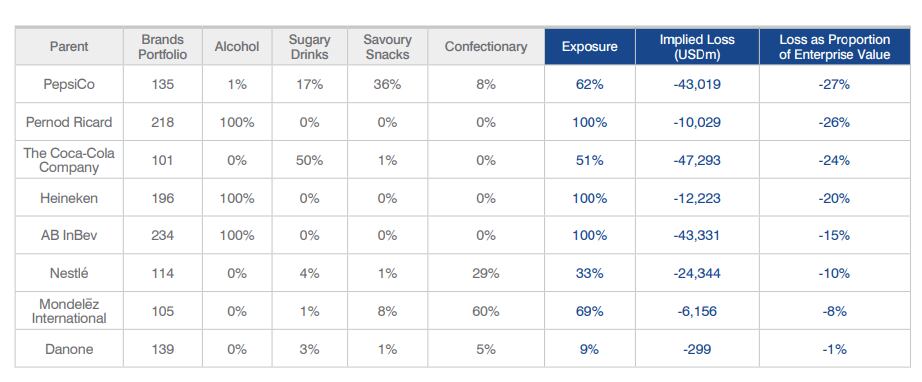It says that alcoholic drinks giants would be almost entirely exposed, and Coca-Cola and PepsiCo would each stand to lose 25% of their enterprise value.
The tobacco industry is obliged to use plain packaging in certain jurisdictions such as Australia and the UK, and calls are emerging for similar measures to be applied to foods and beverages deemed to be unhealthy.
Brand Finance has analysed the potential effect of such a measure: finding a potential loss of $293bn across the beverage industry globally.
Why plain packaging?
In 2012, Australia became the first country to require plain standardized packaging for tobacco products, with several other countries following suit.
Meanwhile, as concerns over obesity grow, an increasing number of jurisdictions have been considering stricter regulations on marketing and advertising of food and drink products.
“With calls for more intrusive measures growing, the prospect of further applications of plain packaging looks increasingly likely,” observes Brand Finance.
Plain packaging: What's the big deal?
Arguments for: Advocates say plain packaging removes visual cues that prompt purchases, and prevents children or other new customers from developing brand loyalty.
Against: Opponents say there is no reliable evidence that plain packaging achieves its aims, merely commoditising well-established brands and leading them to lose market share to cheaper alternatives.
In 2015, the WHO-backed Tobacco Atlas called for plain packaging to be extended to alcohol and some food and drink products. The following year, Public Health England released a report calling for plain packaging to be considered for alcohol, a topic which was raised again recently in the medical journal The Lancet.
Brand Finance has estimated the economic impact of such a policy on four F&B categories – alcohol, sugary drinks, confectionery and savory snacks - but says the effects would go much further.
“To apply plain packaging to these categories would render some of the world’s most iconic brands unrecognisable, changing the look of household cupboards and supermarket shelves forever,” says David Haigh, CEO of Brand Finance.
“Predicted loss of brand contribution to companies at risk is only the tip of the iceberg. Plain packaging also means losses in the creative industries, including design and advertising services, which are heavily reliant on FMCG contracts.”
Number crunching: Financial impact of plain packaging.
Brand Finance analysed the potential effects of the global adoption of such a policy on eight major brand owners: AB InBev, The Coca-Cola Company, Danone , Heineken, Mondelez International, Nestlé, PepsiCo, and Pernod Ricard.
Collectively, these firms control 1,242 brands, 907 of which are alcohol, confectionery, savoury snacks, or sugary drinks.

“Plain packaging would severely limit the effectiveness of these brands as marketing tools, preventing firms from differentiating their products. A before and after analysis of the brand strength of each of the 907 brands owned by these eight firms indicates a loss to enterprise value of $186.7bn.
“The contribution of the analysed brands to their parent companies would fall 33.9% from $551bn to $364bn, seeing overall enterprise value fall 16.5% from $1.133trn to $946.6bn.
“To put this into context, this loss, from just a handful of companies, is equivalent to the GDP of countries such as Kuwait, Vietnam or Romania.”
PepsiCo would have the largest proportion (27%) of its enterprise value at stake.
The Coca-Cola Company would lose the most in absolute terms ($47bn).
Brand Finance then extrapolated the results across all alcohol and sugary drinks brands which have parent companies with an enterprise value of more than $1bn: resulting in an implied loss of at least $293bn across the beverage industry.
You can read the report in full here.
Legislation developments to promote healthy eating
Brand Finance’s report is hypothetical. But with obesity a pressing problem, calls for more drastic measures to improve public health - particularly through what we eat and drink – are increasing.
Taxes, restrictions on marketing and advertising, minimum unit pricing are among measures being introduced or considered.
Last month, Canada’s Yukon became the first territory in the world to introduce sizeable health warning labels on alcohol products, cautioning against the risk of cancer, as part of a study funded by Health Canada.
In Scotland, minimum unit pricing (MUP) for alcohol will be introduced in May next year, making it the first country in the world to do so. Alcohol is currently available at prices as low as 18p per unit: the legislation is expected to create a MUP of 50p per unit. The Scottish government says that MUP is the ‘most proportionate and effective way to reduce the harm caused by cheap, high strength alcohol’.
For non-alcoholic drinks, sugar taxes have been gathering momentum around the globe. Some US jurisdictions have passed legislation for such a measure, while the UK and Ireland will introduce a levy in April.
A number of beverage companies, however are already actively diversifying their portfolios, thus reducing their exposure to potential legislative measures. In non-alcoholic drinks, sugar reduction is a key trend; while there are an increasing number of zero or low alcohol beverages reaching the market.
